Lido di Venezia
 Lido Vaporetto terminal, seen from the Lagoon | |
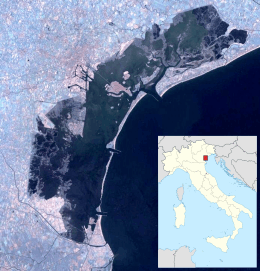 Lido di Venezia Location in the Venetian Lagoon | |
| Geography | |
|---|---|
| Coordinates | 45°24′02″N 12°21′38″E / 45.40062°N 12.360595°ECoordinates: 45°24′02″N 12°21′38″E / 45.40062°N 12.360595°E |
| Adjacent bodies of water | Venetian Lagoon |
| Area | 4 km2 (1.5 sq mi) |
| Length | 11 km (6.8 mi) |
| Highest elevation | 3 m (10 ft) |
| Administration | |
| Comune | Venice |
The Lido, or Venice Lido (Lido di Venezia), is an 11-kilometre (7-mile) long sandbar in Venice, northern Italy; it is home to about 20,000 residents. The Venice Film Festival takes place at the Lido every September.[1]
Geography
The island is home to three settlements. The Lido itself, in the north, is home to the Film Festival, the Grand Hotel des Bains, the Venice Casino and the Hotel Excelsior Venice Lido. Malamocco, in the centre, was the first and, for a long time, the only settlement. It was at one time home to the Doge of Venice. Alberoni at the southern end is home to the golf course. Frequent public buses run the length of the island along the main street.
At least half the Adriatic side of the island is a sandy beach, much of it belonging to the various hotels that house the summer tourists. These include the renowned Hotel Excelsior and the Grand Hotel des Bains, setting for Thomas Mann's classic novel Death in Venice, currently undergoing major renovation. These beaches are private, though towards the northern and southern ends of the island there are two enormous public beaches. The Adriatic Sea is fairly clean and warm, ideal for children, with only the occasional jellyfish to disturb swimming.
The heart of the island is the Gran Viale Santa Maria Elisabetta, a wide street approximately 700 m long that leads from the lagoon and vaporetto (water bus) stop on one side across to the sea on the other. It houses hotels, shops, and tourist-centric restaurants.
Venezia Lido, a public airport suitable for smaller aircraft, is found on the NE end of Lido di Venezia. It has a 1000 m grass runway.
History
In 1177, Emperor Frederick Barbarossa and Pope Alexander III signed the Treaty of Venice here following Frederick's defeat at the Battle of Legnano in 1176.
In 1202, at the beginning of the Fourth Crusade, it was used as a camp by tens of thousands of crusaders, who were blockaded there by the Venetians when they could not pay for the Venetian ships they needed for transport.
In 1857, the first sea bathing facility was set up. This was the first time that anything like it had been seen in Europe and soon, the lido became "The Lido", a byword for a beach resort. The Lido's success and the fascination of Venice nearby made the Lido famous worldwide.
Lido was also famous for its brothels in the first half of the 20th century.
Major beach facilities, hotels and private summer villas have remained the heart of an island that is still known as the "Golden Island".
In the 1960s, the improving post-war Italian economy created a real-estate boom in the island, and many Venetians moved to Lido to benefit from its modern infrastructure.
Legacy
The term Lido, originally coming from this island, is used to refer to certain types of outdoor swimming pools especially in Great Britain, and the "Lido deck" on a cruise ship. It also forms the first part of many place names in coastal locations throughout Italy.
The British travel writer Robin Saikia has written a literary history, The Venice Lido, charting the island's story from its early beginnings to the present day, published by Blue Guides.
Gallery
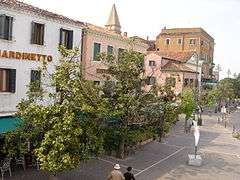 Santa Maria Elisabetta Square
Santa Maria Elisabetta Square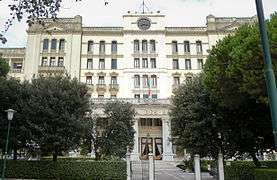
_(1619251977).jpg) Hotel Hungaria Ausonia
Hotel Hungaria Ausonia_(8150652623).jpg) House Licia
House Licia_(8150126764).jpg) Villa Bianca
Villa Bianca_(8150545552).jpg) Villa Elena
Villa Elena_(8150518917).jpg) Villa Lombardi
Villa Lombardi_(8148163554).jpg) Villa Anita
Villa Anita_(8157324911).jpg) Villa Gemma
Villa Gemma_(8150981764).jpg) Villa Perez
Villa Perez_(8148161554).jpg) The former hotel Grande Italia
The former hotel Grande Italia
- In art
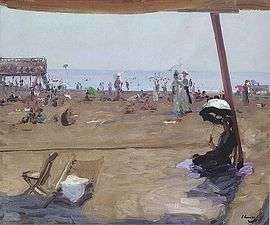 John Lavery, Bathing in the Lido, Venice (1912)
John Lavery, Bathing in the Lido, Venice (1912) Leon Bakst, Bathers on the Lido (before 1923)
Leon Bakst, Bathers on the Lido (before 1923)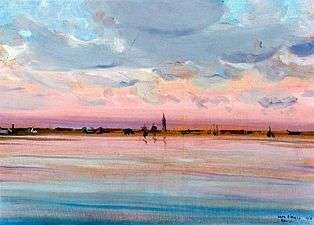 Leon Kaufmann, View of Lido (1926)
Leon Kaufmann, View of Lido (1926) Venise et le Lido, travel poster by Vittorio Grassi
Venise et le Lido, travel poster by Vittorio Grassi
See also
References
- ↑ Hughes, Holly (Jan 14, 2010). "Frommer's 500 Extraordinary Islands". John Wiley & Sons. p. 5. Retrieved 1 December 2013.
External links
| Wikivoyage has a travel guide for Lido. |
| Wikimedia Commons has media related to Lido di Venezia. |
- Satellite image of the Venetian Lido from Google Maps
- Venice Lido Beaches
- Lido di Venezia
- The Venice Lido by Robin Saikia